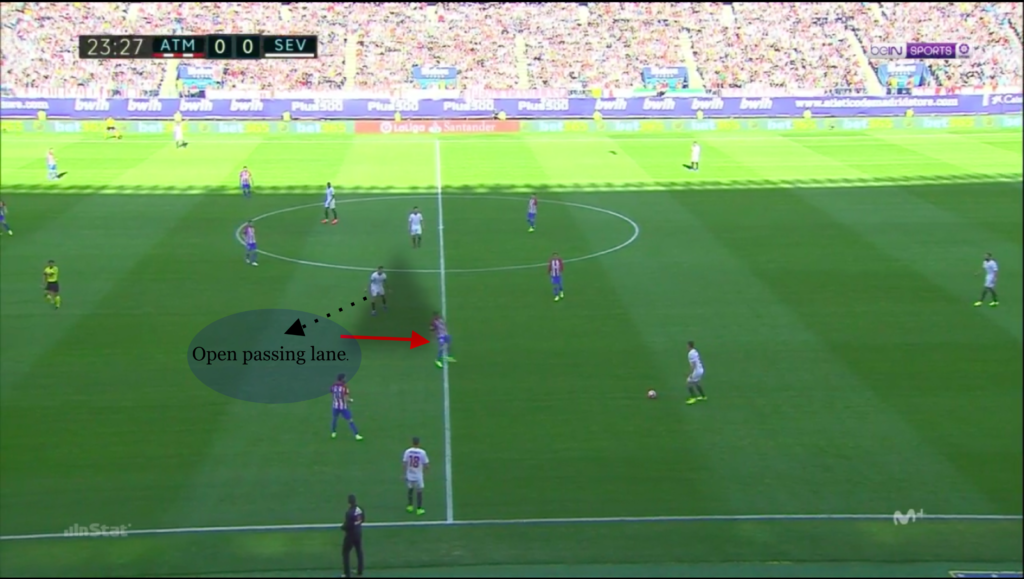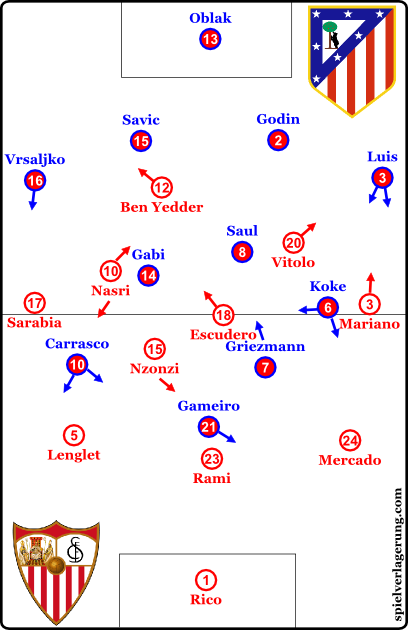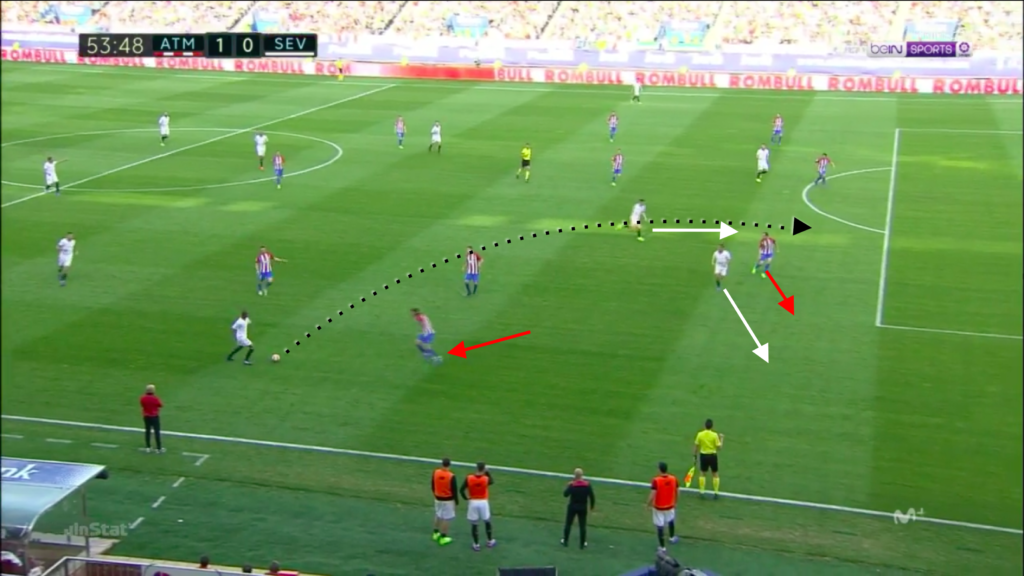Atletico triumph with advancing midfield press
Simeone’s Atletico Madrid hosted Sampaoli’s Sevilla side in an eagerly anticipated 3rd vs 4th clash. An uncharacteristic season for the home side had shown signs of improving in recent weeks, whereas Sevilla’s form had been on the wane.
Much of the first half was defined by the pressing approaches of both sides, and the struggles they had in responding to the press of their opponents.
Sevilla’s pressing from 5-4-1
Starting from a base 5-4-1 shape, Sampaoli’s side held a high block with in a typically man-oriented manner. Beginning with a low intensity, they aimed to encourage dribbles from Atleti’s centre backs whilst blocking off options until they were left without passing options and increasing pressure.
In several situations, Nasri would start as the lone forward, allowing the first pass into one of the centre-backs. Instead of pressing immediately, the Frenchman would move up to prevent switches between the centre-backs, in turn encouraging Godin or Savic to dribble forwards. At the same time, the nearby team-mates would each cover a direct opponent including wide positioning from Vitolo and Ben Yedder to mark Atleti’s full-backs.
Nzonzi and Escudero in midfield stuck particularly tight to their opponents in midfield, often Gabi and Saul. Furthermore the back 5 gave the individual defenders adequate cover to push into midfield and prevent the home side’s attempts to overload the centre with Koke drifting infield. Mercado or Mariano were thus often seen moving up to mark the highest Atletico midfielder.
As the ball carrying centre back dribbled further upfield with all nearby passing options man-marked, Nasri would eventually move across to press. Theoretically, the increasing pressure in addition to a lack of clear passing options would force Godin or Savic into a longer and lower percentage pass, giving Sampaoli’s side a better chance of recovering possession.
Atletico’s advancing midfield press
Simeone’s men put in a typically strong display of midfield pressing from their base 4-4-2 shape. As always, the work started from the positioning of the two forwards who were initially positioned in the centre, either side of Nzonzi preventing Sevilla’s ability to progress through the centre. As such, the away side were gradually guided into wider positions.
Sevilla thus looked towards the side-backs (Mercado and Lenglet) in early build-up. However, Atletico’s quick shifting and compactness meant the midfield line were constantly in position to block passes into the likes of Vitolo. Particularly impressive was the collective body positioning of Atletico’s midfield line, which was clearly geared towards guiding Sevilla to the wings with accurate use of cover shadows.
From these wide positions the roles of the strikers were particularly important in forcing Sevilla to-recirculate through the backline. One flaw that is often seen in pressing schemes, is to block passes into the centre but then lack proper shifting in turn allowing the opponent to access the centre from the wings.
However, Griezmann and Gameiro adjusted their positioning very effectively, moving towards the ball side and using their position to block re-circulation through the centre. This was either done by remaining directly in the passing lane to Nzonzi, or retaining close distances to narrow the passing lane as much as possible.
As such, Sevilla were forced to re-circulate their build-up across the backline and this was where Atletico’s block would begin advancing from their midfield press to pressing Sevilla’s first line. As the ball moved back from side-back to Rami, (the central defender in the 3) Griezmann and Gameiro would move up into more aggressive pressing positions. Atletico’s ball-near striker would move up to press Rami, whilst the ball-far striker would move up diagonally to close the distance to Sevilla’s ball-far side back.
The movement from the ball-far striker was vital here. Since they moved diagonally towards the far side, they prevented Sevilla from opening out and switching the play to the weak side of Atletico’s defence. The ball was thus forced back into an area where the home side had strength in numbers and could create access far easier. Rami would thus be left with the single option of returning the ball to the defender he received from. In these situations Atletico would shift into a 4-3-2-1, with the ball-near central midfielder moving up diagonally to press, using their cover shadow to prevent access to the 10 space.
The ball-carrier would find that re-circulation across the backline was no longer possible, due to the high positions of Atleti’s strikers, in addition the centre was still largely inaccessible due to the diagonal pressing run from Gabi or Saul. The work of the forwards, made Rami’s action very predictable, allowing Atletico’s ball-near Atletico central midfielder to start their press earlier. This meant they had very small distances to Lenglet or Mercado by the time they received the ball, giving them a wider cover shadow.
This advancing midfield press was extremely effective, forcing several turnovers throughout the first half, reducing Sevilla’s threat dramatically and even leading to counter attacking situations.
Conceptual errors in Sevilla’s build-up
Despite the laudable efficacy of the home side’s pressing, there were a number of constant conceptual errors in Sevilla’s build-up that played into making Atletico’s press more effective.
The first and perhaps most important error was the centre backs failing to dribble into the space in front of them. On numerous occasions, Sevilla’s defenders had the ball with no pressure and large space in front of them but failed to dribble forwards into it. This had numerous negative effects on the dynamic of their game. Firstly it harmed their ability to penetrate, with the opposing midfielders content to hold their position and block passing routes into more advanced areas. The lack of dribbles in these situations meant the likes of Gabi and Saul were not forced to move higher to press.
Secondly, the failure to dribble into space meant they did not manipulate Atleti’s forwards, and their early passes often went into areas of more pressure since Griezmann or Gameiro could anticipate the next pass and move to press it. This forced the build-up into gradually worse positions, inviting more pressure whilst each receiver became increasingly isolated from their team-mates, a very bad combination! This eventually led to a number of hopeful balls from isolated positions in deep and wide areas, mostly on the left flank.
This is a perfect example of why coaching instructions need to be more nuanced than “we need to move the ball quicker”, that is often heard from pundits. With an instruction like that, players are trained to make passes as soon as an option is visible, meaning they are not encouraged to take advantage of space and manipulate the opponents, which are vital in creating the best conditions for the receiver.
Another frequent error that harmed Sevilla’s ability to progress was a lack of re-adjustment from players in advanced positions to move out of the cover shadows of their opponents. Moving out of oppositional cover shadows is a simple but vital action for ensuring the ball carrier has passing options. This lack of re-adjustment was also an issue in a vertical sense. As Sevilla’s build-up moved increasingly deeper, their midfielders and forwards were not particularly active in dropping to create connections. This led to the increasing isolation for the ball carrier and the subsequent inability to deal with Atletico’s pressing.
When combined with the aforementioned lack of dribbling from the defenders, Sevilla’s ability to progress was inevitably weak.
Flaws in the responses
In response to the pressing approaches both sides had distinct ways of attempting to bypass the pressure, however both had flaws which meant the plans often failed to yield the desired results.
In response to Sevilla’s press, the home side attempted to play directly from Godin or Savic into the 10 space for a dropping forward (usually Griezmann) to receive. However, these passes were often airborne and chipped, meaning they took long to reach the target. Griezmann would have to lay the ball off to a forwards facing midfielder if the attack was to advance towards goal. These two factors combined created issues for the home side, since the time taken for the ball to travel gave Sevilla’s midfielders time to work back. Nzonzi thus won the ball back on a number of occasions through backwards pressing.
Sampaoli’s side often attempted a similar approach. With Lenglet constantly in isolated positions on the left flank his response was often to play a long diagonal ball towards Ben Yedder. There were two main issues with this, firstly Godin or Savic could exercise their hugely superior height to win the ball when these passes were played too high. Secondly they were too slow to create the supporting structure for the diminutive striker to lay the ball off. As such, he was often unable to retain the ball with intense pressure from Atletico’s centre backs.
On other occasions, Lenglet attempted to play into the ball-near wing-back. However, Atletico could press intensely against the touchline and create a defensive overload with Juanfran and Saul in addition to Gabi and Griezmann working back. This defensive overload allowed Simeone’s side to quickly combine out of the area and attack Sevilla’s back line on the counter when they won possession.
2nd half
Sevilla switch to 4-2-4
At half time, Jovetic replaced Lenglet as Sevilla moved to something of a 4-2-4 with typically variable positioning in attack. Within this shape, the full-backs played asymmetrically with Escudero playing deep, practically in line with the centre backs, on the left, whilst Mariano played high on the right.
Sevilla planned to build up through the left flank, and end their attacks on the right flank. To do so, Escudero was often supported by Vitolo and Nasri drifting around the left half space for combinations. With more effective re-adjustment in addition to less pressure on the ball from Atletico they could progress out of the left flank before switching to Mariano on the right flank.
From here they tried to target channels between the Atletico defenders as they shifted across the pitch, with Sarabia particularly focused on making runs through these channels. When Mariano received these switches, he could engage Filipe Luis in higher positions, pulling the back four across. Sarabia would then make runs between the shifting centre backs and attempt to receive diagonal long balls from Mariano.
In order to give the side a better ability to resist Atletico’s pressing, Sevilla used Nasri and Nzonzi in deeper positions, giving more immediate passing options. However, this led to large disconnects in the positional structure. This had the effect of forcing a direct game from the Andalusian side, as well as leading to vulnerability in defensive transitions.
Atleti threaten on the counter
With their 1-0 lead, Simeone’s men were gradually defending deeper and creating dangerous situations on the counter attack. One factor that increased their threat in these situations were the half space runs from Koke and Carrasco. With runners in either half space, Atletico had the ability to switch the direction of their counter attacks, a factor that also helped to beat Sevilla’s counterpressing.
They also used a number of 3rd man runs, with Griezmann dropping to receive and lay the ball off to Gabi before playing through for the likes of Carrasco.
A number of good situations also arose from goal kicks (both their own and Sevilla’s). They were often able to win the first or second balls with their local density and this assisted them with moving into attack with a strong presence for combinations.
Sevilla more stable, but lack penetration
With the introduction of Iborra along with Atletico’s deeper defending, Sevilla were able to retain possession in the centre far better. With Iborra, Nasri and Nzonzi forming a 3 chain spanning both half spaces, they could outnumber the Atletico forwards and operate in free spaces within Atletico’s 4-4-2.
From here, Correa would often drop to receive and either dribble or combine with Jovetic to continue the attack. In these situations Sevilla often lacked presence, with the increased focus on deep midfield reducing their numbers in attack, they were thus easily outnumbered by Atletico’s defence.
Conclusion
A win for Simeone’s side means they go into the international break, just 2 points behind Sevilla in the race for 3rd place. 3 consecutive league wins, as well as progression to the Champions league quarter-finals have put a positive spin on a previously disappointing campaign.
Sampaoli’s Sevilla are enduring a poor run with no wins in their last 4 games across all competitions. At a crucial stage of the season they have fallen out of the title race and fallen out of the Champions League with defeat to Leicester. The issues in a disconnected structure in possession seem to be persistent and will likely need ironing out if Sevilla are to improve their form.






2 Kommentare Alle anzeigen
fluxkompensator March 23, 2017 um 9:24 am
thanks for this article. very interesting match up indeed.
could you explain in detail what that collective body positioning is about?
cheers
JD March 29, 2017 um 9:10 pm
In this case I was referring to the midfielders adjusting and using their cover shadows to block passes into the space in and around them. Part of this was about reacting to team-mates, so responding well to a team-mate leaving the line to press by covering the space and gradually guiding the opponent to the wings. The strikers were also a big part of this, moving across to block the 6 space and forcing Sevilla to circulate through the back line.